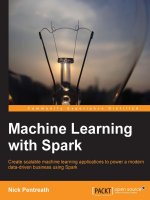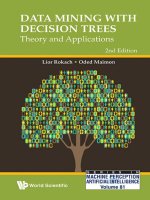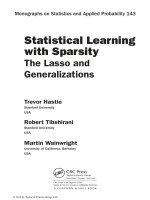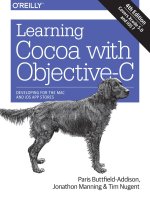IT training application delivery with mesosphere DCOS 1 khotailieu
Bạn đang xem bản rút gọn của tài liệu. Xem và tải ngay bản đầy đủ của tài liệu tại đây (2.57 MB, 110 trang )
Co
m
pl
ts
of
Andrew Jefferson
en
Building and Running
Modern Data-Driven Apps
im
Application
Delivery
with DC/OS
Application Delivery
with DC/OS
Building and Running Modern
Data-Driven Apps
Andrew Jefferson
Beijing
Boston Farnham Sebastopol
Tokyo
Application Delivery with DC/OS
by Andrew Jefferson
Copyright © 2017 O’Reilly Media, Inc. All rights reserved.
Printed in the United States of America.
Published by O’Reilly Media, Inc., 1005 Gravenstein Highway North, Sebastopol, CA
95472.
O’Reilly books may be purchased for educational, business, or sales promotional use.
Online editions are also available for most titles ( For more
information, contact our corporate/institutional sales department: 800-998-9938 or
Editors: Brian Anderson and Virginia
Wilson
Production Editor: Nicholas Adams
Copyeditor: Octal Publishing, Inc.
Interior Designer: David Futato
Cover Designer: Randy Comer
Illustrator: Rebecca Demarest
First Edition
April 2017:
Revision History for the First Edition
2017-03-28:
First Release
The O’Reilly logo is a registered trademark of O’Reilly Media, Inc. Application Deliv‐
ery with DC/OS, the cover image, and related trade dress are trademarks of O’Reilly
Media, Inc.
While the publisher and the author have used good faith efforts to ensure that the
information and instructions contained in this work are accurate, the publisher and
the author disclaim all responsibility for errors or omissions, including without limi‐
tation responsibility for damages resulting from the use of or reliance on this work.
Use of the information and instructions contained in this work is at your own risk. If
any code samples or other technology this work contains or describes is subject to
open source licenses or the intellectual property rights of others, it is your responsi‐
bility to ensure that your use thereof complies with such licenses and/or rights.
978-1-491-98342-3
[LSI]
Table of Contents
Foreword. . . . . . . . . . . . . . . . . . . . . . . . . . . . . . . . . . . . . . . . . . . . . . . . . . . . . . v
1. Introduction. . . . . . . . . . . . . . . . . . . . . . . . . . . . . . . . . . . . . . . . . . . . . . . . 1
2. Why Do We Need Modern Enterprise Architecture?. . . . . . . . . . . . . . . 5
Highly Connected World
Operations
Application Development
Hardware and Infrastructure
Analytics, Machine Learning, and Data Science
Business Value
Chapter Conclusion: MEA Requirements
6
8
9
10
11
13
17
3. Understanding DC/OS. . . . . . . . . . . . . . . . . . . . . . . . . . . . . . . . . . . . . . . 21
Getting Started with DC/OS
How DC/OS works
DC/OS Packages
DC/OS CLI
22
23
31
41
4. Running Applications in DC/OS. . . . . . . . . . . . . . . . . . . . . . . . . . . . . . . 43
Marathon (for apps) and Metronome (for jobs)
44
5. Writing Applications to Run on DC/OS. . . . . . . . . . . . . . . . . . . . . . . . . 53
Service Discovery in DC/OS
Managing Persistent State in DC/OS
External Persistent Volumes
Publishing Applications and Services
53
61
65
68
iii
Section Conclusion: Example Applications on DC/OS
70
6. Operating DC/OS in Production. . . . . . . . . . . . . . . . . . . . . . . . . . . . . . . 75
Scaling
Dynamic Workloads
Multidatacenter DC/OS Configuration
Deployment
Deploying a DC/OS Package
Security in DC/OS
Disaster Planning and Business Continuity
75
77
78
78
83
87
93
7. Implications of Using DC/OS. . . . . . . . . . . . . . . . . . . . . . . . . . . . . . . . . . 95
How DC/OS Addresses Enterprise Application Architecture
Requirements
96
Conclusion
100
iv
|
Table of Contents
Foreword
In 2009, my UC Berkeley colleagues and I observed that the world
of computing was changing from small applications powered by
large machines (where VM-partitioning made sense), to larger apps
powered by clusters of low-cost machines. The explosion of data
and users meant that modern enterprise apps had to become dis‐
tributed systems, and we needed a way to easily run this new type of
application. Later that year we published a research paper titled
“The Datacenter Needs an Operating System.”
Managing users and data at scale were real-world problems faced by
companies like Twitter and AirBnB. VM-centric (or even containercentric) approaches were too low level—what mattered were the
services running on top, e.g., Spark and Kafka. Moreover, each of
these services re-implemented the same set of functionalities (e.g.,
failure detection, monitoring). We needed something to enable
these services to run on aggregated compute resources, abstracting
away the servers underneath, just like we abstract away the resources
in our laptops, servers, smartphones, tablets, etc. We needed an
operating system for the datacenter.
Replacing the word “computer” with “datacenter” in the Wikipedia
definition of an operating system captures this need succinctly: “A
collection of software that manages the datacenter computer hard‐
ware resources and provides common services for datacenter com‐
puter programs.”
DC/OS—our datacenter operating system—began with the Apache
Mesos distributed system kernel, which we started at UC Berkeley
and then used in production at Twitter and other organizations. In
April 2016, Mesosphere open sourced DC/OS. Today, 100+ services
v
are available at the click of a mouse, including data services like
Apache Spark, Apache Cassandra, Apache Kafka, and ElasticSearch
—and more. Developers can choose the services they want, while
operators can pick any infrastructure they’d like to run on.
I hope you enjoy this book.
— Ben Hindman, Apache
Mesos PMC Chair &
Mesosphere Cofounder
vi
|
Foreword
CHAPTER 1
Introduction
In this report, I introduce DC/OS and the Modern Enterprise Archi‐
tecture proposed by Mesosphere for building and operating soft‐
ware applications and services. I explain in detail how DC/OS works
and how to build applications to run on DC/OS. I also explain how
the Modern Enterprise Architecture can meet the needs of organiza‐
tions from startups to large enterprises, and how using it can benefit
software development, systems administration, and data strategy.
Here are some brief descriptions to help familiarize you with these
terms:
DC/OS
This stands for Data Center Operating System, which is a sys‐
tem composed of Linux nodes communicating over a network
to provide software-defined services. A DC/OS Cluster provides
a software-defined platform on which applications can be
deployed and which can scale to thousands of nodes in a data‐
center. DC/OS provides an operational approach and integrated
set of software tools to run complex multicomponent software
systems and manage the operation of those systems.
Mesosphere
Mesosphere is the company that created DC/OS. It sells Meso‐
sphere Enterprise DC/OS (the enterprise version of DC/OS). In
the words of Mesosphere CEO and cofounder Florian Leibert:
1
Mesosphere is democratizing the modern infrastructure we
used at Twitter, AirBnB, and other web-scale companies to
quickly deliver data-driven services on any datacenter or
cloud.
Modern Enterprise Architecture
This is a system proposed by Mesosphere for building services
using DC/OS to run multiple software applications powered by
distributed microservices. Applications and microservices run
in containers, and DC/OS packages are used to provide stateful
and big data services.1
The benefits of using DC/OS and the Modern Enterprise Architec‐
ture are both tactical (improved reliability, better resource utiliza‐
tion, and faster software development) and strategic (collecting and
extracting more value from data, having flexibility to deploy oncloud or on-premises hardware using open source technologies).
In the central part of this report, I explain what DC/OS is and how it
works. This explanation introduces the internal components of
DC/OS in enough depth that you should be able to run applications
on DC/OS without it seeming magical or mysterious. In the final
chapter, I describe specific approaches that you can use with DC/OS
to build, deploy, and operate software applications.
This report is intended for the principal users of DC/OS:
• System administrators responsible for the operation and uptime
of applications and services
• Software engineers responsible for building applications and
services to run on DC/OS
• Systems architects responsible for the design of systems and
computing infrastructure.
This report also should be useful for you if you have any of these
roles: DevOps, AppOps, QA, product manager, project manager,
CTO, or CEO. For the technical sections of the report, I assume that
you have experience in building and running networked (client/
server) applications and using Linux.
1 />
2
|
Chapter 1: Introduction
If you read this report from cover to cover, you should learn enough
to identify situations in which DC/OS could be used and what bene‐
fits it could bring. If you are interested in the details of how DC/OS
works but not why you should use it, you can skip the first and last
chapters and concentrate on the central part of the report.
Glossary
The majority of the terminology used in this report is taken from
the DC/OS documentation (available at />view/concepts/). I recommend using this documentation as a refer‐
ence when reading the technical sections of this report.
For now, though, there are some terms that have fairly flexible
meanings in general use, but in this report, I use them in very spe‐
cific ways:
• Server is used only to mean a software application that
responds to requests from other applications.
• Node is a single virtual or physical machine running a Linux
OS on which a Mesos agent or Mesos master process runs.
DC/OS nodes are networked together to form a DC/OS cluster.
• Operations is used to refer to the activities and responsibilities
of keeping a software system up and running in a live environ‐
ment. Operations tasks are typically carried out by systems
administrators, although different organizations use different
practices or terminology.
• Software development is used to refer to the activities and
responsibilities of creating new software or making changes to
existing software. Software development tasks are typically car‐
ried out by software engineers, although different organizations
use different practices or terminology.
Introduction
|
3
CHAPTER 2
Why Do We Need Modern
Enterprise Architecture?
In this chapter, we explore the reasons that have motivated people to
develop and use systems like DC/OS. Examples of similar systems
are Google’s Borg cluster-management system and tools like Kuber‐
netes or Docker Swarm. These allow software-defined systems to
control and run tasks on clusters of computing nodes (which can be
virtual or physical). The reasons for the development of these sys‐
tems are diverse including organizational, infrastructure, and appli‐
cation requirements.
We’ll explore each of the different areas, and as we go through each,
I will pick out specific requirements that I think DC/OS and Meso‐
sphere’s Modern Enterprise Architecture (MEA) are addressing. If
you think that you have some if these requirements, you might ben‐
efit from using DC/OS.
A common question I hear—and one that I faced myself when I
began considering using DC/OS—is this: “I have been making soft‐
ware applications successfully for years without DC/OS: what has
changed that means I should change my approach?”
Here are my personal reasons for adopting DC/OS:
• The operational requirements (reliability, performance, connec‐
tivity) of the internet-connected applications I was building
have changed dramatically over the past five years.
5
• Data (storage, collection, and analysis) has become of para‐
mount importance and great value to organizations and the
technical requirements to support machine learning and artifi‐
cial intelligence (AI) technologies required a change in the tech‐
nologies and approaches that I was using.
Let’s take a step back and look at the broader changes that have
motivated the development of DC/OS and similar systems.
Highly Connected World
We live in a highly connected world,1 and the expectations that peo‐
ple have of this connectivity are higher than they have ever been:
businesses and consumers expect around-the-clock access to highquality information, analysis, and services.
To meet the expectations of users, organizations must build and
operate interconnected, always-on applications that a range of plat‐
forms can consume. Connected devices now include not only
phones and PCs, but also electricity meters, refrigerators, and ship‐
ping containers. Systems are communicating more data, more fre‐
quently, and using more platforms than ever before. Accordingly,
organizations need their systems to be scalable, highly available, and
resilient.
Because consumers have high expectations and multiple ways of
accessing services, even a simple consumer or business software
product can require multiple connected services that interact with
one or more stateful record stores. It is no longer enough for a busi‐
ness to have a good website, they also want the following:
• Device-specific apps that work with the following:
— Smartphones
— Smartwatches
— Virtual Reality (VR)
• Service-specific integrations with entities such as these:
— Major providers such a Google or Microsoft
— Personal services such as Facebook and Twitter
1 />
6
|
Chapter 2: Why Do We Need Modern Enterprise Architecture?
— Business software such as SalesForce, Xero, and Sharepoint
• New ways of interacting with users:
— Virtual assistants like Alexa, Siri, and OK Google
— Chatbots
— Augmented Reality (AR)
To improve decision making and develop their competitive advan‐
tage, businesses want to collect and analyze information about these
frequent and increasingly complex interactions. This requires
investment in business processes, technology, and application devel‐
opment. Making the best use of data requires adopting big data, fast
data, and machine learning strategies.
Building applications for this highly connected environment
requires the ability to rapidly develop new software and update
existing applications without introducing bugs or affecting reliabil‐
ity. Software development and operational strategies have emerged
to facilitate this, such as Continuous Integration (CI), A/B testing,
Site Reliability Engineering (SRE), Service (and microservice)Oriented Architectures (SOA), and Agile development methods.
From this section, I can list these specific requirements that the
MEA must have to be useful in our highly connected world:
• Can scale to support tens of thousands of simultaneous connec‐
tions
• Can scale to support tens of thousands of transactions/second
• Resilience to expected failures (loss of nodes or a network parti‐
tion)
• Fast, large volume (terabyte–petabyte scale) data collection and
storage
• Fast, arbitrary analytics on live and stored data
• Support for modern software development methodologies
• Support for modern operational practices
From this list, you can see that the requirements I have for the MEA
are not just about specific technical details (such as the support for
simultaneous connections). It also needs to meet the broader
requirements of teams that work with it (such as supporting the
Highly Connected World
|
7
software development methodology). In the next sections, we’ll
investigate some of the different areas that are affected by the MEA.
Operations
It takes more to run an application in production than installing
some software and starting applications. For operators, their job
truly begins on day two—maintaining, upgrading, and debugging a
running cluster without downtime.2
In this report, I am using “operations” as a term to refer to all the
tasks that arise to keep applications and services up and running.
Traditionally, system administration has involved routine manual
intervention to keep systems functioning correctly. These opera‐
tional approaches have had to evolve to meet the needs of alwayson, highly connected modern systems. Advanced operational
approaches have been developed coining terms such as Day 2 Ops,
DevOps, and the aforementioned SRE. These approaches use soft‐
ware to define system configuration and automate operational tasks.
SRE is a term that originates from Google, and the SRE approach is
set out in an excellent book that is available online for free.3 The aim
of SRE is to deliver an optimal combination of feature velocity and
system reliability. The responsibilities of SRE, as defined by Google,
are availability, latency, performance, efficiency, change manage‐
ment, monitoring, emergency response, and capacity planning.
That provides a good summary of the typical concerns of an opera‐
tions team. Operations is highly technical, and the efficiency and
effectiveness of the operational team is dependent on many details
of the systems that it uses and maintains. It is essential that an MEA
addresses operational requirements and supports a range of opera‐
tional approaches. Here are key operational tools and practices:
• Containerization
• Orchestration
• Dynamic service discovery
• Infrastructure as code
2 />3 />
8
|
Chapter 2: Why Do We Need Modern Enterprise Architecture?
• Continuous integration
• Continuous deployment
It is neither effective nor scalable for daily operations task or failure
handling to be manual processes. Operational teams need systems
that can automatically respond within milliseconds to problems that
arise so that they are self-healing and fault tolerant. To provide relia‐
bility and meet uptime requirements, the MEA should include not
only redundancy but also capacity to correct faults itself. To fully
realize the benefits of operational automation, teams need to be able
to program systems to work with their in-house applications and to
perform tasks according to their specific business requirements.
This ability to program and customize operational systems behavior
is another requirement I have of the MEA.
Application Development
Businesses want their software development teams to produce new
applications and features with shorter timescales to keep up with
technology developments and fast-changing usage patterns. Exam‐
ples of recent developments that prompt organizations to want to
develop new applications are AR and VR and an explosion of smart
devices.
To rapidly develop applications, software engineering teams have
widely adopted methodologies focused on maintaining a high speed
of development. At the same time, it is also necessary that software
meet high standards of reliability and scalability. To deliver reliable,
scalable applications and develop quickly, software engineers want
to make use of reliable high-level abstractions, which they consume
as services through SDKs and APIs. Here are some examples of
these high-level services:
• Databases
• Message queues
• Object storage
• Machine learning
• Authentication
• Logging and monitoring
Application Development
|
9
• Data processing (map-reduce)
By using high-level abstractions, software engineers can develop
new applications more quickly and efficiently. Using well-known
and well-tested systems for underlying services can also contribute
to the reliability and scalability of the resulting application.
Having access to a wide range of sophisticated abstractions
improves both software development and system operation. For
example, if software engineers have access to a graph database, a
transactional relational database, and a highly concurrent key-value
database, they can make use of each database for appropriate tasks.
Choosing the right tool for the job makes both development and
subsequent operation much more efficient than attempting to force
tasks onto an unsuitable service.
To allow fast and versatile application development, the MEA
should allow us to easily use a range of high-level service abstrac‐
tions provided by well-known, reliable, and scalable implementa‐
tions.
Hardware and Infrastructure
Any organization deploying an enterprise application needs to con‐
sider what computing infrastructure it will use—predominantly, this
decision is focused on computing and network hardware but can
include many other concerns. Deciding on what infrastructure to
use is an extremely significant and difficult decision to make for
many businesses, and choices typically have long-lasting conse‐
quences.
Before we go further into this topic, it is important to stress that
DC/OS can run on a wide range of computing infrastructures,
including on-premises datacenters and cloud platforms; it does not
require you to use a particular infrastructure.
Cloud computing platforms provide a spectrum of services, from
bare-metal servers to high-level abstractions like databases and mes‐
sage queues, as described in the previous section. Examples of com‐
panies that provide these services include Amazon Web Services
(AWS), Google Cloud, Microsoft Azure, RapidSwitch, and Heroku.
The major cloud providers are widely used; have extremely good
Service-Level Agreements (SLAs); provide a range of sophisticated
10
|
Chapter 2: Why Do We Need Modern Enterprise Architecture?
management and configuration tools; and offer myriad pricing
options, including pay-as-you-go. Using cloud platforms has many
advantages for organizations compared with the alternatives. For the
majority of organizations, building and operating all of the neces‐
sary infrastructure on-premises is a significant undertaking and
often requires making infrastructure, software, or architectural
design compromises to use fewer or less-sophisticated devices and
tools in order to be feasible.
There are many benefits to using cloud platforms but there are also
drawbacks:
• Problems of vendor lock-in
• Difficulty of compatibility or interoperation with existing onpremises systems
• Lack of transparency about how services are implemented
• Information security concerns
• Lack of control over service provision and development
• Regulatory restrictions
• Specialized performance or hardware requirements
• Financial considerations
In some cases, to avoid dependence on a single provider, some
organizations set up systems to use multiple platforms or use a com‐
bination of on-premises and cloud platforms, which adds complex‐
ity.
So, we will add the requirement that the MEA should not force you
to use a specific cloud or on-premises infrastructure. It should work
equally well on a range of computational infrastructure. Further‐
more, it should allow you to use the same configuration and man‐
agement tools, irrespective of the underlying infrastructure provider
so that it is possible to use multiple providers easily.
Analytics, Machine Learning, and Data Science
Modern, highly connected businesses and software systems have
access to huge amounts of information. In recent years, the scope
for software systems to collect, analyze, and ultimately generate
intelligence from data has increased exponentially.
Analytics, Machine Learning, and Data Science
|
11
Effective collection and exploitation of data from software systems is
being used by businesses to build significant competitive advan‐
tages. To make the most from the opportunities requires systems to
have the capacity to collect, store, and analyze large volumes of data.
Subsequent to analysis, organizations need to incorporate the results
of that analysis into the operation and decision-making process.4
Real-time analytics is most commonly associated with advertising,
sales, and the financial industries, but it is now finding uses in an
entire range of applications; for example, to provide system admin‐
istrators with Canary metrics5 or using machine learning and pre‐
dictive analytics to automatically scale infrastructure and services in
datacenters.6
An ideal machine learning system automatically analyzes informa‐
tion from live systems and uses the results to make predictions and
decisions in real time. To realize the value from data, an MEA must
treat data collection, storage, and analytics as principal concerns
fully supported by the system architecture and incorporated into
software development and system operation.
Many existing application architectures such as the 12-factor app
were developed to address the needs of applications that run as serv‐
ices and use localized, transactional data architectures (such as SQL
databases) for storing data. In these data architectures, analysis is
performed as a separate function, typically one removed from live
systems requiring Extract, Transform, and Load (ETL) processes
and separate data warehouse infrastructure. These systems are
costly, difficult to adapt to changing data models (slowing develop‐
ment), and, most important, take a long time to close the loop
between data collection, analysis, and action. A data-driven service
architecture still has all of the requirements of an architecture such
as the 12-factor app, but it has additional requirements related to the
automation of collection and analysis of data.
The requirement that we have for the MEA is that it will support the
collections, storage, and analysis of large amounts of data and that it
will allow us to easily use the tools and techniques of modern data
4 />5 />6 />
12
|
Chapter 2: Why Do We Need Modern Enterprise Architecture?
science, such as distributed storage and computing systems
(Hadoop, Spark, and so on).
Business Value
Back when IT was just infrastructure, your tech stack wasn’t a com‐
petitive business asset. But when you add data into the equation—
that changes the game. For example, both Netflix and HBO create
original programming and distribute their content. Only Netflix is
able to analyze viewer behavior in detail and use that to inform pro‐
gramming and content creation.
—Edward Hsu, VP product marketing, Mesosphere
Software systems and computing infrastructure have been seen by
many organizations as a cost of doing business—a cost similar to
office leases or utility bills. But for successful technology companies,
software systems and computing infrastructure are valuable busi‐
ness assets. Time and money well invested can provide a valuable
return or competitive advantage. The competitive advantage can be
realized in many ways including from exploiting data, as illustrated
in the quote opening this section, from taking advantage of new
technologies or from being able to deliver new and more sophistica‐
ted applications faster than competitors.
The easiest benefit for businesses to realize by improving their sys‐
tem architecture is in improvements to the performance of teams
that work directly with software and systems in areas such as the fol‐
lowing:
Data collection and analysis
Increasing the value extracted from data. Reducing associated
infrastructure and support costs.
Software development
Increasing feature velocity. Making more data-driven decisions.
Operations
Improved uptime and reliability. Reduced operational costs.
Faster recovery times.
These are the topics that have been discussed in the previous sec‐
tions of this chapter. Taking a more holistic view, there are other
strategic business considerations when making technology choices:
• Avoiding vendor lock-in
Business Value
|
13
• Human resource considerations
• Control and visibility of infrastructure
• Information security and regulatory requirements
The majority of the concerns covered in this section are about man‐
aging business risk rather than meeting a specific technical require‐
ment. The weight that you apply to these risks when making
architecture choices will depend on your beliefs about risks and
your tolerance for accepting risks in different areas.
Vendor Lock-In
Vendor lock-in occurs when a business is heavily reliant on a prod‐
uct or service that is provided by a supplier (vendor). An example is
the reported reliance of Snapchat on Google Cloud, as Snapchat’s
S-1 filing (part of its IPO documentation) states:
Any disruption of or interference with our use of the Google Cloud
operation would negatively affect our operations and seriously
harm our business.
Lock-in like this poses a risk because the supplier might stop provid‐
ing or change the nature of its services, or the supplier can take
advantage of the locked-in customer by increasing the price that it
charges. Vendor lock-in usually arises because there are no alternate
providers or there are significant technical or financial costs to
switch to an alternate provider. With many technology products,
numerous small technical differences between similar services mean
that there can be significant switching costs, and so vendor lock-in is
a common risk when making technology choices. For example,
cloud platforms such as AWS, Azure, and Google Cloud Platform
provide similar services, but there are differences between the APIs,
SDKs, and management tools for those services, which means that
moving a system from one to another would require significant soft‐
ware engineering work.
Technology lock-in occurs when a business is heavily reliant on a
specific technology; for example, a company can become locked-in
to a particular database software because it contains large amounts
of critical business data, and moving that data to an alternative data‐
base software is too difficult or expensive.
A situation which is less commonly mentioned is when an organiza‐
tion becomes locked-in to using internal services such that it has
14
| Chapter 2: Why Do We Need Modern Enterprise Architecture?
high switching costs to transition to alternatives. Sometimes, this
might be technology lock-in, but it is in many cases more similar to
vendor lock-in except that the vendor is a department internal to the
company. This is a situation that our architecture should avoid and
discourage from occurring—if it facilitates on-premises provision of
products and services, it should also allow for easy transition to
external products and services. A common example of this is busi‐
nesses that are locked-in to the use of on-premises IT infrastructure
and face significant switching costs to transition to cloud infrastruc‐
ture despite many potential advantages to doing so. The best way to
avoid lock-in is to choose an architecture and systems that keeps
switching costs to a minimum.
Lock-in is a situation that businesses want to avoid and so can be a
significant concern when making architecture choices. In some
cases, organizations put a lot of money and effort into setting up
systems so that they can use multiple technology providers to avoid
reliance on a single supplier.
Because of this, the MEA should minimize vendor and technology
lock-in. Specifically, for a software system, this means that the archi‐
tecture should allow us to use a range of different software systems
to provide services (databases, message queues, logging, and so on)
and it should make it easy to switch between different providers.
Human Resources
Choosing a technology, however technically appropriate, for which
there are few competent or experienced engineers and/or adminis‐
trators available creates risks:
• Will it be possible to hire or subcontract sufficient engineers to
make use of the technology?
• Can the organization develop sufficient expertise to maintain
the technology after it’s in place?
In some cases, making bold and unusual technical choices can have
significant benefits, usually when the advantage of technical perfor‐
mance in a specific area is more important than other concerns. In
general, however, staffing risks can make a more common technol‐
ogy with a larger or less-expensive talent pool a better choice than
an unusual choice, even if it is a better technical fit. Following are
some human-resource concerns:
Business Value
|
15
• Skills and experience that exist within the organization
• Cost and availability of skills and experience
• Projection of future cost and future availability of skills and
experience
Technology and architecture choices can have dramatic effects on
staffing requirements by allowing tasks to be automated or out‐
sourced. In particular, modern software orchestration systems (such
as those provided by cloud platforms and DC/OS) automate or facil‐
itate automation of an entire range of tasks, particularly operational
tasks. There is also massive scope in making use of improved data
architectures and machine learning software to reduce the workload
associated with analytics and data science.
The MEA should allow us to automate operational and data tasks,
and the technologies used should have good availability of skilled
and experienced engineers and operators so that it is easy for the
business to find competent staff.
Control
Regardless of contracts and SLAs, provision of services by third par‐
ties exposes businesses to certain risks. In some extreme cases, pro‐
viders have discontinued services, choosing to break contracts
rather than continue unprofitable activities. In other cases, custom‐
ers have lost access to systems and infrastructure when the business
providing them has failed to pay its bills (e.g., for power or network
access) or filed for bankruptcy. A more common occurrence is that
periodically providers update their services, changing tools and
interfaces, which forces users to spend engineering effort to change
their applications to use the updated tools/interfaces.
For some businesses in regulated industries, there might be con‐
cerns about the ability of third parties to comply with regulatory
requirements, particularly regarding privacy and security.7
The MEA should work both for businesses that want to exercise a
high level of control over their infrastructure/systems, but it should
7 There are people who argue that a specialized infrastructure provider is able to do a
better job on security or regulatory compliance than in-house solutions. I am not mak‐
ing the case either way—I’m just explaining that this is a position some businesses take.
16
|
Chapter 2: Why Do We Need Modern Enterprise Architecture?
not create extra work for those who are more easy-going or who
want to outsource infrastructure provision to specialist third parties.
Regulatory and Statutory Requirements
Information systems and companies that operate them are subject to
legal and regulatory requirements. Many countries have privacy or
data protection laws, and certain industries or business require‐
ments have more stringent requirements. Here are some examples:
• HIPAA affects personal medical and healthcare-related infor‐
mation in the United States.
• PCI DSS has requirements for systems that handle credit card
and other personal banking information
• European Union Data Protection rules apply to Personally Iden‐
tifiable Data in Europe
Here are some examples of requirements resulting from regulation:
• Localization of data; for example, EU Data Protection Rules
place restrictions on the transfer of personal data outside of the
EU.
• Logging and audit; for example, PCI DSS requires that systems
log access to network and data, and it should be possible to
audit those logs.
• Authentication and access control; for example, many informa‐
tion security regulations require that users should be appropri‐
ately authenticated to access data.
Our enterprise architecture should not prevent meeting these or
other regulatory requirements. It should make typical requirements
such as localization, auditing, and authentication straightforward to
enforce and manage.
Chapter Conclusion: MEA Requirements
I have provided some context for the situations in which DC/OS is
commonly used and identified a range of requirements for the MEA
to meet, from technical requirements, such as the ability to deliver
internet-connected applications that can handle high transaction
rates, to broader requirements, such as facilitating operational and
Chapter Conclusion: MEA Requirements
|
17









